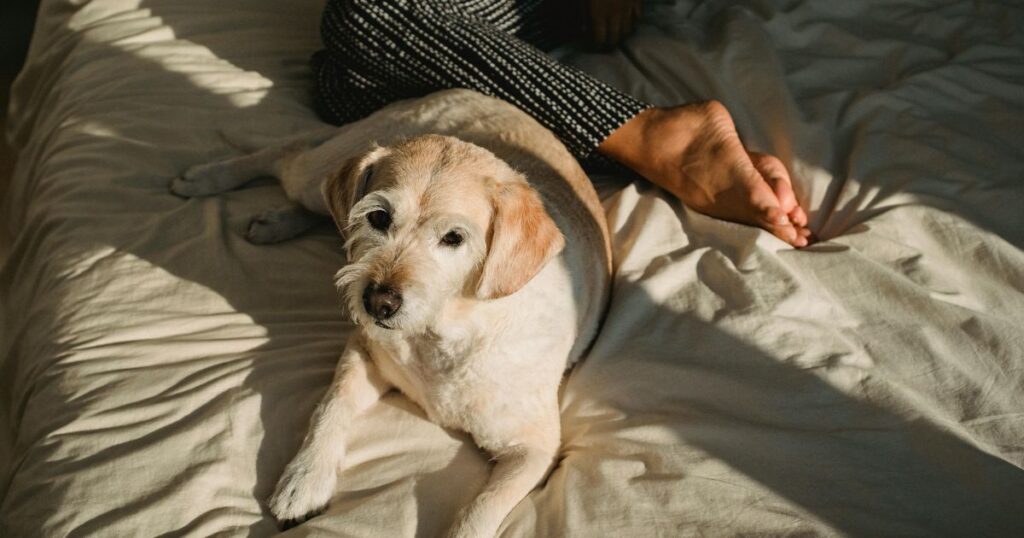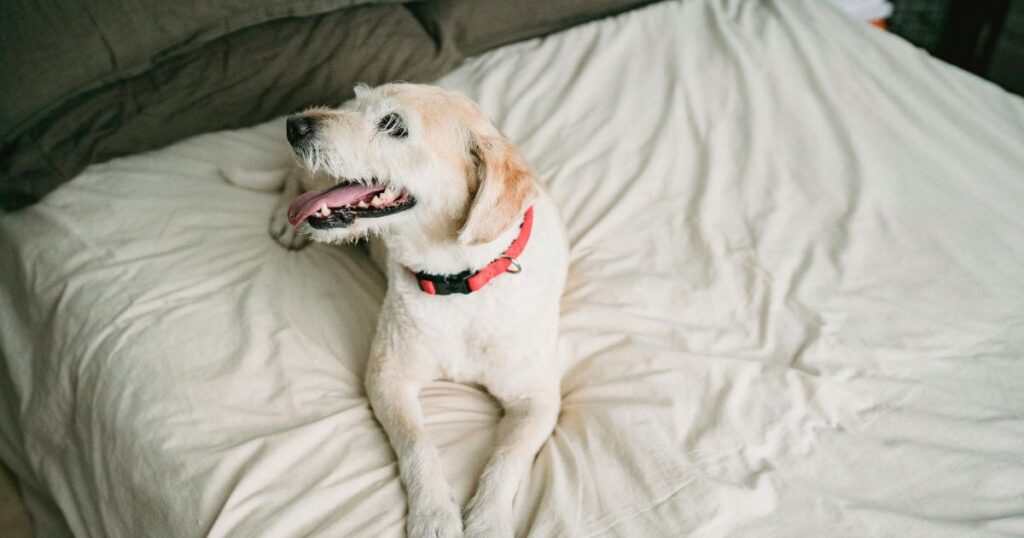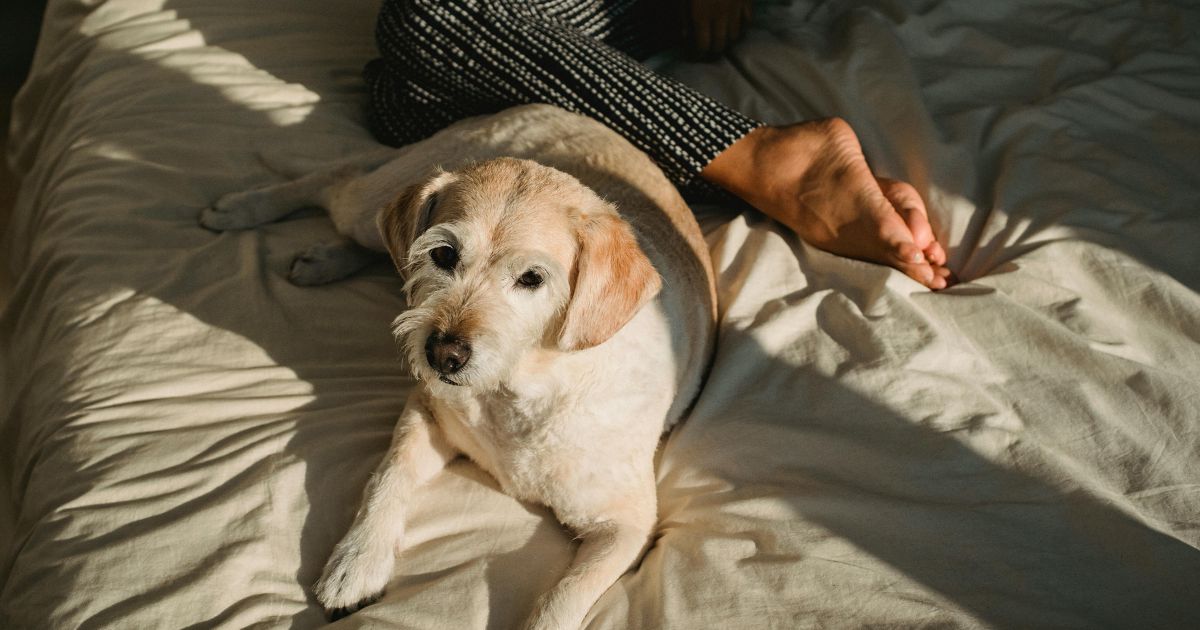As an Amazon Associate, I earn from qualifying purchases
How Do I Stop My Dog from Destroying His Bed: To stop your dog from destroying his bed in the crate, provide durable chew toys and increase exercise. Ensure the bedding is tough and not too plush.
Dealing with a dog that tears up its bed in the crate can be frustrating and expensive. Owners must address this behavior promptly to avoid the development of destructive habits. A key to solving this problem lies in understanding why a dog might engage in such behavior.
Boredom, excess energy, anxiety, or simply the irresistible texture of the bedding can all contribute. By redirecting your dog’s attention and energy to more appropriate outlets, you can safeguard the bed and ensure your dog remains content and stimulated.
Offering durable chew toys can keep your dog occupied, while ramping up the physical activity can help tire them out, reducing the likelihood of bed destruction. Choosing the right bedding—durable and less enticing to chew—also plays a crucial role. This multifaceted approach helps create a positive crate experience for your dog, preserving the bed and your peace of mind.
Why Do Dogs Destroy Their Beds?

There can be various reasons for dogs to destroy their beds from instincts that are hard-wired in the breed, or due to behavioral issues. For example, puppies often chew on beds when teething to provide relief for their sore gums.
If your dog is older and doing it, then they are likely to be behaving this way due to things such as boredom or excess energy (older dogs tend not to get the amount of exercise that younger ones need). Others may well destroy their bedding in an anxiety-fraught situation.
Alternatively, the destruction occurs because of need — like tearing up a bed to make it more comfortable or pawing at its material that triggers innate urges to dig and nest. Knowing the root of these tendencies is important when you want to act on them correctly.
Why Do Dogs Scratch Their Beds?
Dogs often scratch their beds due to instinctive behaviors inherited from their wild ancestors. This action can serve multiple purposes:
- Nesting: Dogs naturally scratch at their sleeping areas to make them more comfortable, creating a nest that fits their body shape or adjusts the bed’s temperature.
- Marking Territory: By scratching, dogs might be trying to leave their scent in the bed, which comes from scent glands in their paws. This can make the space feel more secure and familiar.
- Temperature Regulation: In the wild, scratching the ground could help to expose cooler soil during hot weather or warmer spots in colder conditions. Similarly.
Why Do Dogs Pee On Their Beds?
Dogs peeing on their beds can be perplexing and problematic for pet owners, but this behavior often has identifiable causes:
- Marking Territory: Some dogs pee on their beds as a way of marking their territory, especially if there are other pets in the home. This can be more common in dogs that aren’t neutered or spayed.
- Anxiety or Stress: Emotional distress can lead some dogs to urinate where they sleep. This could be triggered by changes in the environment, new pets, new people, or other stressors that make the dog feel insecure or anxious.
- Medical Issues: Health problems such as urinary tract infections, diabetes, or conditions that increase urine production
How To Stop Dogs From Destroying Their Beds
Stopping dogs from destroying their beds can be challenging, but with consistent efforts and understanding, you can address this behavior effectively. Here are some strategies to consider:
- Provide Adequate Exercise: Ensure your dog gets enough physical and mental stimulation daily. Dogs often destroy their beds out of boredom or excess energy. Long walks, runs, and interactive games can help burn off this energy.
- Use Durable Beds: Invest in chew-resistant or indestructible dog beds. These are specifically designed to withstand heavy chewing and can be a worthwhile investment if your dog is particularly destructive.
- Provide Appropriate Chew Toys: Supply your dog with plenty of durable chew toys. These can divert your dog’s need to chew away from the bed. Toys that can be stuffed with food or treats are particularly effective as they keep your dog engaged and satisfied.
- Training and Commands: Teach your dog commands such as “leave it” or “no chew.” Training your dog to understand these commands can help prevent bed destruction as you can intervene before the behavior escalates.
The Problem(How Do I Stop My Dog from Destroying His Bed)
Picture this: a house filled with torn fabrics, chewed corners, and a sad dog bed in shreds. This scene is all too familiar for some pet owners. Dogs often rip up their beds, leaving a mess and an unhappy owner.
Dogs destroy beds in crates for many reasons. They might feel bored, anxious or just have a natural chewing instinct. Understanding and tackling this costly behavior is a must for any caring dog owner.
Destructive Behavior In Crates
Dogs in crates can sometimes become little whirlwinds of destruction. They chew, tear, and rip their bedding apart. This can lead to two main issues:
financial strain from replacing beds and health risks for your dog. Choking on fabric or ingesting stuffing is a risk you can avoid.
- Boredom is a common trigger.
- Anxiety can lead to destructive actions.
- Chewing is an instinct for dogs.
| Reasons | Consequences |
|---|---|
| Chewing | Damaged bed |
| Boredom | More destruction |
| Anxiety | Health risks |
Once the underlying cause of the behavior is discovered, a solution is easier to find. Simple adjustments to a dog’s routine or providing more suitable toys can often help.
Understanding The Behavior
Dogs are known for their playful nature and sometimes destructive habits, especially when it comes to their beds. To address this, we first need to delve into the reasons behind their behavior.
It’s not just about boredom or excess energy. Various factors contribute to this issue, and understanding them is key to finding a solution.
Reasons For Crate Destruction
- Teething Puppies: Young dogs chew to soothe their gums.
- Boredom: Dogs need activities to stay engaged.
- Anxiety: Separation or fear can lead to chewing.
- Lack of Training: Pets may not know bed chewing is bad.
- Seeking Attention: Dogs sometimes act out to get noticed.
Distinguishing between these reasons is crucial. It helps you decide the best approach to stop the behavior. Each dog is unique, so the solution should fit its specific needs. Identifying the trigger is the first step towards a chew-free crate.
Preventive Measures
As a devoted dog owner, keeping your furry friend happy and their crate in one piece is paramount. Prevention is key, and with a few smart choices, you can successfully deter your pooch from turning their bed into a pile of fluff. Here’s how to protect that cozy den.
Choosing A Sturdy Bed
Select a chew-resistant bed designed to withstand the jaws of your canine companion. Your furry friend’s bed must be not only comfortable but also tough. Look for beds with durable materials like heavy-duty nylon or reinforced corners.
They should resist tears and chewing attempts. Features like non-grip materials or anti-chew coatings can be extra deterrents against destruction.
Proper Introduction To The Crate
Introducing your dog to their crate the right way can make all the difference. Start with short sessions and gradually increase the time. Always associate the crate with positive experiences.
Fill it with favorites like treats or toys. Never use the crate for punishment. With a positive association, your dog will be less likely to vent frustration on their bed.
- Begin with short intervals in the crate.
- Use praise and treats for positive reinforcement.
- Keep the environment calm to minimize anxiety.
Ensuring your dog sees their crate as a haven rather than a punishment spot reduces stress, discouraging destructive behavior. Adopt these preventive measures and protect your investment in a quality bed for your dog’s crate.

How Do I Stop My Dog from Destroying His Bed
Positive Reinforcement Training
Imagine you and your furry friend enjoying a peaceful night. Your dog calmly sleeps in his crate without the urge to turn his bed into a pile of fluff. This dream can become a reality with positive reinforcement training. This method rewards your dog for their good behavior, encouraging them to repeat it.
Rewarding Calm Behavior
Every time your dog relaxes in their crate without nibbling on the bed, it’s celebration time. Hand out tiny treats or give them their favorite belly rubs to show you approval.
The key is consistency. Make sure to reward them every time they display calm behavior in the crate. Use these steps:
- Step 1: Wait for your dog to lie down on the bed calmly.
- Step 2: Quietly approach and provide a treat or pet gently.
- Step 3: Use a happy yet calm voice to praise them.
Stick to this routine and watch as your dog starts understanding that calmness equals rewards.
Redirecting Chewing
Does your dog love to chew? That’s normal. It’s their way of exploring the world. Yet, when the bed in the crate is the target, redirection is key. Keep chew toys nearby and whenever your dog starts eyeing the bed with those chompers, swap out the bed for a toy. Follow these guidelines to redirect their chewing:
- Notice when your dog is about to chew on the bed.
- Immediately offer a chew toy as an alternative.
- Encourage them to take the toy with positive words.
With time and patience, your dog will learn that toys are for chewing, not their comfy bed.
Providing Mental And Physical Stimulation
Dogs need brain games and workouts just like we do. Without them, they get bored. Bored dogs look for fun. Fun for them might mean chewing up their bed. To stop this, keep their minds and bodies busy.
Regular Exercise
Walks and playtime are great for your furry friend. They burn energy. Tired dogs are happy dogs. And they are less likely to destroy their beds. Aim for:
- Two walks a day: One in the morning, one in the evening.
- Playtime in the yard:: This could include fetch or tag.
Interactive Toys And Puzzles
Think of toys that make your dog think. Treat-dispensing puzzles work well. They challenge the brain. They keep your dog busy and out of trouble. Here’s a list of interactive toys:
- Puzzle toys: Place treats inside, and watch your dog solve it.
- Kongs: Fill them with peanut butter, a big hit with pups.
Your Dog Has Separation Anxiety

Separation anxiety can often lead to undesirable behavior in dogs, such as destroying their beds. When left alone, these feelings of distress may cause your furry friend to take out their frustrations on their sleeping quarters.
Combating this issue requires patience, understanding, and a structured approach. Let’s explore effective strategies to help your pet feel more relaxed when alone.
Gradual Alone Time Training
Building your dog’s tolerance to being alone is essential. Start with short periods of separation and gradually increase the time. Follow these steps:
- Begin by leaving your dog in the crate for just a few minutes.
- Slowly extend the time by a few minutes for each session.
- Stay calm and avoid making a fuss when leaving or returning.
- Reward calm behavior with treats and affection.
- Provide a comforting toy or blanket that helps soothe your dog.
Consistency with this training can significantly reduce your dog’s anxiety levels.
Seeking Professional Help
If your efforts at home don’t seem to work, professional help may be needed. Consider the following:
- Consult with a veterinarian to rule out any medical issues.
- Seek a certified animal behaviorist for specialized intervention.
- Explore the possibility of anxiety medication under veterinary supervision.
Professional guidance can provide personalized strategies to manage your dog’s separation anxiety.
Consulting A Vet
Dogs tearing apart their beds can be frustrating. Often, the issue is not just behavioral. Health concerns might trigger this behavior.
Speak with your vet to rule out any underlying health problems. A professional can spot symptoms that aren’t obvious at first glance.
Health Check H3 Section
Evaluating Health Issues
Start with a comprehensive health check. This confirms if pain or discomfort is causing distress. Here are steps to consider:
- Expert examination to pinpoint issues.
- Regular check-ups to prevent health-related anxiety.
- Discuss activity levels; too much or too little can cause stress.
How Do I Stop My Dog from Destroying His Bed
Frequently Asked Questions For How Do I Stop My Dog From Destroying His Bed In His Crate
Why Does My Dog Destroy His Bed In His Crate?
Dogs may destroy their beds due to anxiety, boredom, or the instinct to chew. Providing ample exercise and chew toys can help minimize this behavior.
Quest: How Do I Get My Dog To Stop Chewing His Bed In His Crate?
Ans: To stop your dog from chewing his bed in his crate, provide him with chew-resistant beds and plenty of durable chew toys. Ensure he gets ample exercise and mental stimulation throughout the day. Use deterrent sprays on the bed and reinforce training with consistent commands and rewards.
Quest: How Do I Train My Dog Not To Destroy His Bed?
Aans: Start by providing durable, chew-resistant beds. Use positive reinforcement to reward non-destructive behavior. Deter destructive chewing with safe, bitter sprays. Ensure your dog has plenty of exercise and engaging toys.
Quest: How Do I Stop My Dog From Tearing Up His Dog Bed
Ans: To prevent your dog from tearing up his bed, provide plenty of chew toys, engage in regular exercise, and use durable beds designed for chewers. Implement training to discourage destructive behavior.
Conclusion
When your dog is an incessant chewer, it can be frustrating. However, overcoming this challenge saves his bedding and makes him happy. Insist on routine training and challenging toys.
In the end, keeping your dog’s needs and addressing his behavior leads to a calm crate experience. In short and simple words keep the bed of your fur baby comfortable & intact every night.
As an Amazon Associate, I earn from qualifying purchases

